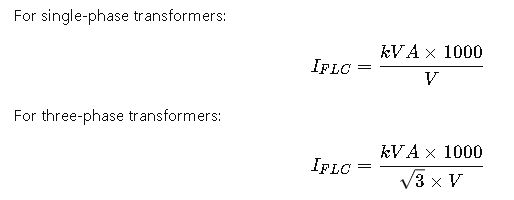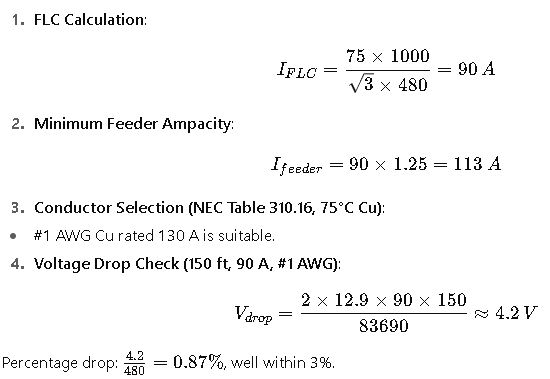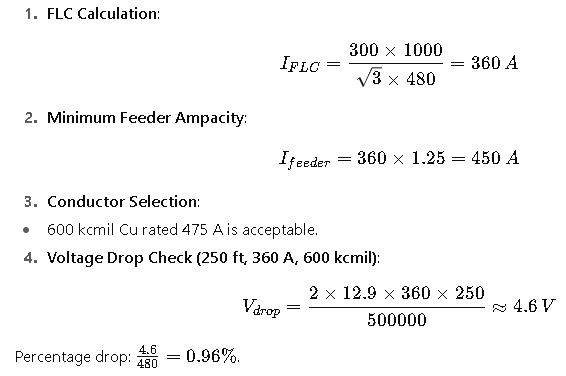Correct feeder cable sizing for transformers is vital in electrical engineering, ensuring safe, efficient, and reliable operation. The NEC establishes precise requirements covering transformer conductors, overcurrent protection, and ampacity adjustments for consistent compliance.
Feeder Cable Sizing for Transformers — NEC (Quick Calculator)
Calculate transformer full-load currents (primary & secondary), minimum conductor ampacity and recommended OCPD sizes — based on kVA, voltage and phase. Use as a design aid; always verify with local code and a licensed electrician.
How is full-load current calculated?
Why 125% for continuous loads?
Do you size the OCPD here?
Why Feeder Cable Sizing Matters in Transformer Installations
Feeder conductors are responsible for carrying current between the main distribution system and transformer terminals. If undersized, cables can overheat, leading to insulation breakdown, voltage drop, fire hazards, or premature transformer failure. Oversizing cables, on the other hand, increases material costs and installation complexity.
Therefore, engineers must carefully balance ampacity requirements, overcurrent protection, temperature correction factors, and NEC compliance to ensure a reliable system.
Core NEC References for Transformer Feeder Cable Sizing
When designing transformer feeders, the following NEC Articles are most relevant:
- Article 215 – Feeders
- Article 240 – Overcurrent Protection
- Article 250 – Grounding and Bonding
- Article 310 – Conductors for General Wiring
- Article 450 – Transformers and Transformer Vaults
Each article addresses different aspects such as conductor sizing, ampacity tables, protection methods, and grounding requirements.
Key Formulas for Transformer Feeder Cable Sizing
The following formulas are essential for determining feeder cable size according to NEC. Each variable is explained in detail with typical values.
1. Transformer Full-Load Current (FLC)

- kVA = Transformer rating in kilovolt-amperes (commonly 15, 30, 45, 75, 112.5, 150, 225, 300, 500, 750, 1000, 2000).
- V = System voltage (120, 208, 240, 277, 480, 600 V are typical in NEC systems).
2. Minimum Feeder Ampacity
- Sf= Safety factor according to NEC. For transformer primary conductors, NEC requires at least 125% of the rated current (per NEC 450.3).
3. Voltage Drop Consideration
NEC recommends a maximum 3% voltage drop for feeders:
Where:
- K = Resistivity constant (12.9 for copper, 21.2 for aluminum, at 75°C).
- I = Load current (A).
- L = One-way length of conductor (ft).
- CM = Conductor circular mil area.
4. Conductor Ampacity Adjustment
From NEC 310.15(B)(2):

Extended NEC-Based Feeder Cable Sizing Tables
The following tables provide practical feeder sizing references. These are based on 75°C rated copper conductors using NEC 2023 ampacity tables, assuming typical transformer kVA ratings and voltages.
Table 1 – Full-Load Currents for Common Transformer Ratings (Three-Phase)
| Transformer kVA | 208 V | 240 V | 480 V | 600 V |
|---|---|---|---|---|
| 15 kVA | 42 A | 36 A | 18 A | 14 A |
| 30 kVA | 83 A | 72 A | 36 A | 29 A |
| 45 kVA | 125 A | 108 A | 54 A | 43 A |
| 75 kVA | 208 A | 180 A | 90 A | 72 A |
| 112.5 kVA | 312 A | 270 A | 135 A | 108 A |
| 150 kVA | 416 A | 360 A | 180 A | 144 A |
| 225 kVA | 625 A | 540 A | 270 A | 216 A |
| 300 kVA | 833 A | 720 A | 360 A | 288 A |
| 500 kVA | 1389 A | 1201 A | 601 A | 481 A |
| 750 kVA | 2083 A | 1802 A | 902 A | 722 A |
| 1000 kVA | 2778 A | 2402 A | 1203 A | 962 A |
Table 2 – Minimum Feeder Ampacity (125% Rule)
| Transformer kVA | 480 V FLC (A) | Min Feeder Ampacity (125%) | Suggested Feeder Conductor (Cu, 75°C) |
|---|---|---|---|
| 45 kVA | 54 A | 68 A | #4 AWG (85 A) |
| 75 kVA | 90 A | 113 A | #1 AWG (130 A) |
| 112.5 kVA | 135 A | 169 A | 2/0 AWG (175 A) |
| 150 kVA | 180 A | 225 A | 4/0 AWG (230 A) |
| 225 kVA | 270 A | 338 A | 500 kcmil (380 A) |
| 300 kVA | 360 A | 450 A | 600 kcmil (475 A) |
| 500 kVA | 601 A | 751 A | 2 × 500 kcmil in parallel |
| 750 kVA | 902 A | 1128 A | 3 × 500 kcmil in parallel |
| 1000 kVA | 1203 A | 1504 A | 4 × 500 kcmil in parallel |
Table 3 – Voltage Drop Factors for Common Conductor Sizes (Copper, 75°C)
| Conductor Size (AWG/kcmil) | Area (CM) | Resistance (Ω/1000 ft) | Voltage Drop (V/100 ft @ 100 A, 480 V) |
|---|---|---|---|
| #4 AWG | 41740 | 0.321 | 3.2 V (0.7%) |
| #1 AWG | 83690 | 0.126 | 1.3 V (0.3%) |
| 2/0 AWG | 133100 | 0.078 | 0.8 V (0.2%) |
| 4/0 AWG | 211600 | 0.049 | 0.5 V (0.1%) |
| 500 kcmil | 500000 | 0.025 | 0.25 V (0.05%) |
| 750 kcmil | 750000 | 0.017 | 0.17 V (0.04%) |
Real-World Examples of Transformer Feeder Cable Sizing
Case 1 – 75 kVA, 480 V Three-Phase Transformer, 150 ft Feeder Run

Final Selection: #1 AWG copper, 75°C rated insulation.
Case 2 – 300 kVA, 480 V Three-Phase Transformer, 250 ft Feeder Run

Final Selection: 600 kcmil copper, 75°C rated insulation.
NEC Rules Governing Feeder Cable Sizing for Transformers
The National Electrical Code (NEC) does not only provide mathematical guidance but also sets practical rules for real-world installations. These rules ensure that conductor sizing is not just theoretical but applicable to installation conditions, environmental factors, and safety standards.
Here are the most relevant principles:
- Primary Side Conductor Sizing
- Conductors supplying transformer primaries must be rated at at least 125% of the transformer’s rated primary current (NEC 450.3).
- This ensures protection against overloads while allowing normal operating tolerances.
- Secondary Side Conductor Sizing
- Secondary conductors must follow NEC 240.21(C), which provides special rules since secondary conductors are not always directly protected by OCPDs at their source.
- Secondary conductors are sized based on length limitations, overcurrent protection location, and load requirements.
- Overcurrent Protection
- Per NEC 240, the overcurrent protective device (OCPD) must protect conductors without exceeding their ampacity.
- For transformers, this typically means a circuit breaker or fuse sized according to 125–250% of primary FLC, depending on transformer type and installation.
- Ampacity Adjustments and Corrections
- Conductors installed in ambient temperatures above 30°C (86°F) must be derated per NEC 310.15.
- Where more than three current-carrying conductors are in a raceway or cable, derating factors also apply.
- This often leads engineers to select larger conductors than the theoretical calculation suggests.
- Voltage Drop Considerations
- Although not strictly a code requirement, NEC recommends a maximum 3% voltage drop for feeders and 5% total for feeders plus branch circuits.
- In large industrial installations, minimizing voltage drop improves efficiency and reduces energy costs.
- Parallel Conductors
- For currents exceeding the largest standard conductor size (2000 kcmil), NEC allows parallel conductors.
- Engineers often use multiple runs of 500 kcmil or 750 kcmil to carry very large transformer feeder currents.
Practical Tables for Common Transformer Feeders
Beyond formulas, engineers rely on lookup tables when selecting feeder cables. These tables allow quick decisions during design and installation.
Table 4 – Recommended Copper Feeder Sizes for Standard Transformers (480 V, 3-Phase, 75°C)
| Transformer kVA | FLC (A) | Min Feeder Ampacity (125%) | Typical Feeder Cable Size |
|---|---|---|---|
| 15 kVA | 18 A | 23 A | #10 AWG Cu (30 A) |
| 30 kVA | 36 A | 45 A | #8 AWG Cu (50 A) |
| 45 kVA | 54 A | 68 A | #4 AWG Cu (85 A) |
| 75 kVA | 90 A | 113 A | #1 AWG Cu (130 A) |
| 112.5 kVA | 135 A | 169 A | 2/0 AWG Cu (175 A) |
| 150 kVA | 180 A | 225 A | 4/0 AWG Cu (230 A) |
| 225 kVA | 270 A | 338 A | 500 kcmil Cu (380 A) |
| 300 kVA | 360 A | 450 A | 600 kcmil Cu (475 A) |
| 500 kVA | 601 A | 751 A | 2 × 500 kcmil Cu (Parallel) |
| 750 kVA | 902 A | 1128 A | 3 × 500 kcmil Cu (Parallel) |
| 1000 kVA | 1203 A | 1504 A | 4 × 500 kcmil Cu (Parallel) |
This table assumes copper conductors at 75°C. For aluminum, sizes increase by about two conductor sizes.
Real-World Engineering Considerations
Designing transformer feeders goes beyond calculations. Let’s look at critical engineering factors every professional considers.
1. Copper vs. Aluminum Conductors
- Copper: Higher conductivity, smaller size, better mechanical strength, but more expensive.
- Aluminum: Larger size required, more affordable, lighter, but needs special terminations and anti-oxidation treatment.
- Common practice: Use copper for smaller feeders (<400 A) and aluminum for large feeders (>400 A) where cost savings are substantial.
2. Installation Environment
- Conductors installed in underground conduits face higher ambient temperatures, requiring derating.
- Outdoor feeders must account for UV exposure, moisture, and physical damage.
- Industrial facilities often require special insulation types like XHHW-2 or THHN for durability.
3. Short-Circuit Withstand
- Conductors must withstand fault currents until protective devices clear the fault.
- For high kVA transformers, short-circuit currents can be extremely high, so proper coordination with OCPDs is critical.
4. Parallel Runs and Raceway Fill
- Large feeders are often installed in parallel runs.
- NEC requires equal length, same material, and same termination for each parallel conductor to ensure current sharing.
- Raceway fill must also comply with NEC Chapter 9 to prevent overheating.
Example – Industrial Plant Transformer Feeder
Consider a 500 kVA transformer, 480 V, three-phase, feeding a motor control center located 200 ft away.
- Load Current: ~601 A (from tables).
- Minimum Feeder Ampacity: 751 A (125%).
- Feeder Selection: Two parallel sets of 500 kcmil copper (each rated 380 A) give 760 A capacity.
- Voltage Drop: At 200 ft, drop remains <2%, within NEC recommendations.
- Decision: Engineer chooses 2 × 500 kcmil Cu in parallel per phase, in separate conduits for easier pulling.
This design ensures NEC compliance, efficiency, and practical installation.
Advanced Example – Multiple Transformers in One Feeder System
In large commercial buildings, it is common to have several smaller transformers supplied from one main feeder. For example, three 75 kVA transformers on a common 480 V feeder.
- Each transformer requires ~113 A feeder ampacity (after NEC factor).
- The combined load = 3 × 113 A = 339 A.
- Engineer sizes the main feeder at 400 A minimum, selecting 500 kcmil aluminum (430 A) to balance cost and performance.
- Each transformer secondary still requires individual protection per NEC 240.21(C).
This approach highlights how system-level coordination is just as important as per-transformer sizing.

